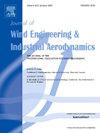Aerodynamic characterization of bicycle wheels: Development of a reversed-fork setup for drag and ventilation moment measurement
IF 4.9
2区 工程技术
Q1 ENGINEERING, CIVIL
Journal of Wind Engineering and Industrial Aerodynamics
Pub Date : 2025-09-18
DOI:10.1016/j.jweia.2025.106240
引用次数: 0
Abstract
Aerodynamic resistance plays a fundamental role in cycling races. Since competition time gaps are continuously narrowing, aerodynamic optimization of technical equipment has gained crucial relevance. Therefore, wheel aerodynamics has been extensively investigated through wind tunnel experiments and numerical simulations. Although it has been demonstrated that ventilation moment accounts for a significant portion of wheel power losses, it is not measured in most wind tunnel tests concerning bicycle wheels. This paper aims to introduce and validate a setup in which the bicycle wheel is supported by a reversed fork, enabling the simultaneous measurement of rotational power losses and aerodynamic forces. The presence of the fork can produce a more realistic flow field, potentially offering insights into the frame-wheel interaction. The proposed methodology combines a coast-down test and an inertia measurement to estimate the rotational power loss due to ventilation moment with maximum uncertainty of about 1%. The outcomes of the tests agree with the results reported in the literature, indicating that the flow behavior is accurately captured. Comparison with previous wind tunnel campaigns conducted within the same facility, but with a different setup on the same wheel-tire assembly, revealed consistent trends of translational drag force and steering moment with yaw angle.
自行车车轮的空气动力学特性:用于阻力和通风力矩测量的反叉装置的开发
空气阻力在自行车比赛中起着至关重要的作用。随着比赛时间差距的不断缩小,技术装备的气动优化具有至关重要的意义。因此,通过风洞实验和数值模拟对车轮空气动力学进行了广泛的研究。虽然已经证明通风力矩占车轮功率损失的很大一部分,但在大多数关于自行车车轮的风洞试验中没有测量它。本文旨在介绍并验证一种设置,其中自行车车轮由一个反向叉支撑,能够同时测量旋转功率损失和空气动力。叉的存在可以产生更真实的流场,潜在地提供对车架-车轮相互作用的见解。所提出的方法结合了滑行测试和惯性测量来估计由于通风力矩造成的旋转功率损失,最大不确定性约为1%。试验结果与文献报道的结果一致,表明准确地捕获了流动特性。与之前在同一设施内进行的风洞试验相比,在相同的车轮-轮胎组件上进行了不同的设置,发现平移阻力和转向力矩随偏航角的变化趋势一致。
本文章由计算机程序翻译,如有差异,请以英文原文为准。
求助全文
约1分钟内获得全文
求助全文
来源期刊
CiteScore
8.90
自引率
22.90%
发文量
306
审稿时长
4.4 months
期刊介绍:
The objective of the journal is to provide a means for the publication and interchange of information, on an international basis, on all those aspects of wind engineering that are included in the activities of the International Association for Wind Engineering http://www.iawe.org/. These are: social and economic impact of wind effects; wind characteristics and structure, local wind environments, wind loads and structural response, diffusion, pollutant dispersion and matter transport, wind effects on building heat loss and ventilation, wind effects on transport systems, aerodynamic aspects of wind energy generation, and codification of wind effects.
Papers on these subjects describing full-scale measurements, wind-tunnel simulation studies, computational or theoretical methods are published, as well as papers dealing with the development of techniques and apparatus for wind engineering experiments.

 求助内容:
求助内容: 应助结果提醒方式:
应助结果提醒方式:


